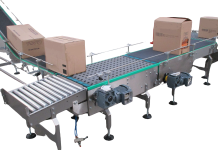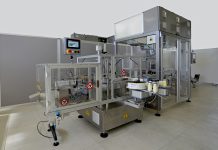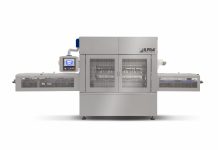
The search for maximum efficiency in the packaging lines requires solutions that make it possible to compensate for the inevitable idle stops that can occur in the various machines in the chain.
As production rates increase, it becomes essential to have good buffering spaces available to avoid having to stop production upstream, especially in the presence of processes that cannot be interrupted instantly or even cannot be stopped at all (a typical example could be that of an industrial oven). LIFO buffer systems represent the ideal solution for dry products with long shelf life such ask pastries, biscuits, snacks and sweets, pasta, rice or coffee. These systems give the most value for the money in term of available buffering space. M.H. Material Handling meets these needs with the BAT Buffer and Heliflex accumulation systems. Both products are LIFO (Last In First Out) type buffers:
- BAT Buffer uses the BAT table top chain; the structure of the machine is composed of spires with straight sections of variable length between 2.5 and 6 meters and curves with an average radius of 200 mm to minimize the lateral dimensions. The buffer is capable of reaching lengths up to 150 m (which can be extended adding other spirals side by side). The structure is fully configurable in order to adapt to a wide range of products.
- Heliflex instead uses a special chain with cantilevered slats and self-stacking features. The chain wound on two drums, climbing on one and descending on the other, reaching a maximum capacity of about 500 m for larger machines reaching the lowest cost per buffering meter on the market. It is specially fitting for flowpack or trays, but have more limitations in term of product height that should not exceed 80 mm. The footprint is about 2,5×5 meters and up to 3,6 meters in height.

For both systems, product insertion takes place via a diverter system placed on the main line which, when the downstream machine stops, directs the incoming products to the buffer.
The movement of the chain is controlled thanks to the action of an inverter and a inlet flow photocell; this allows the insertion of the products on the buffer by controlling the pitch so that they do not come into contact with each other, maintaining zero pressure and avoiding possible damage, while maximizing the available space. When the downstream machine becomes available again or in the event that upstream production stops, the buffer reverses its direction of travel and begins the unloading phase.
The re-insertion of products online can take place in two ways, the choice of which is linked to whether or not the direction of travel is maintained with respect to the time of insertion.
- In the event that the products must necessarily maintain the direction of travel in which they entered the buffer, a product return system is provided by means of an orthogonal, pneumatic or motorized transfer device.
- In the event that the direction of movement of the products is indifferent to production purposes, the return can be made by means of a fixed deviation on an unloading belt and therefore by means of a unification system with the main line.



